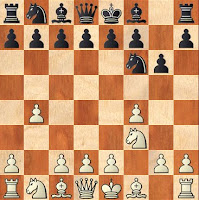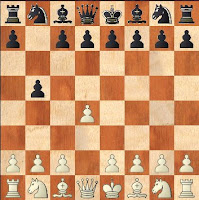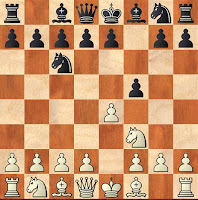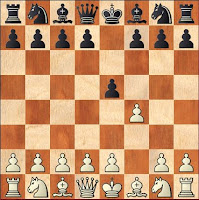
The completely unorthodox gem was dug up from the depths of the Unorthodox Openings Newsletter #18. Black completely ignores the center and in a hypermodern way attacks it from a fianchettoed Queen's bishop. After a Bishop move by White, Black moves the King's Knight pawn up to f7!!?? This of course is the weakest square in the Black camp. This breaks all opening rules and after computer analysis, it would be shown that this defense is totally unsound. Well, suprise suprise, it isn't. After running an 96 1 min game engine tournament with 4 engines it seems the odds aren't 'too' bad. The final score was 60 wins for White, 3 Draws, and 33 wins for Black. Not too shabby for a defense that uses the move f7! Some suprising points to me, being a patzer and all, emerged from these games.
1. The Knights seem to dominate the minor pieces in the wins with black. They dominate until they are traded off. Many fancy sacrifices with the Knights were seen too.
2. f7, although the weak square a lot of times became the base of a pawn chain directly attacking the king side.
3. With a Kingside attack coming the King is either used very aggresively in this attack or is tucked away safely by a Queenside castle. When it is in the attack is usually because it has moved because of the weakness at f7. Which is funny because the weak square forces the King to join in the fight on the Kingside.
4. And a great suprise for me is that the computers often ignore the weak square and instead opt for rapid development and then attack that weak square. By that time though Black has usually build up defenses around that weak square or has prep'd a Queenside castle or Kingside attack.
I was shocked by this opening and then bewildered by its ability to fight for the win. I suggest reading the UON # 18 for the full analysis by a master. The PGN for the games can be found here:
unicorn defense.
.
The results were:
.
unicorn2 Ballmer 2008
Rybka 2.3 LK 32-bit 18.0/28 226.50
HIARCS 11.1 UCI 18.0/28 219.00
Deep Shredder 10 UCI 10.5/29 155.25
Fritz 9 10.5/29 147.75
.
These are the 3 final wins by Black.
.
[Event "unicorn2"]
[Site "Ballmer"]
[Date "2008.07.01"]
[Round "15.2"]
[White "Rybka 2.3 LK 32-bit"]
[Black "HIARCS 11.1 UCI"]
[Result "0-1"]
[SetUp "1"]
[FEN "rn1qkbnr/pbppp1pp/1p3p2/8/3PP3/3B4/PPP2PPP/RNBQK1NR w KQkq - 0 1"]
[PlyCount "144"]
[EventDate "2008.07.01"]
[EventType "tourn"]
[Source "Dozer"]
1. Nc3 e6 2. Nf3 Bb4 3. Bd2 Ne7 4. a3 Bxc3 5. Bxc3 O-O 6. O-O f5 7. exf5 Nxf58. Qe2 Nc6 9. g3 Qe7 10. Rad1 a5 11. Qe4 Rae8 12. g4 Nd8 13. Qe2 Nh6 14. Nd2Ndf7 15. f3 Ng5 16. Ne4 Nh3+ 17. Kh1 Nf4 18. Qe3 d5 19. Nf2 e5 20. Rde1 Qh4 21.Bb5 c6 22. Ba4 Ba6 23. Rg1 Ne2 24. dxe5 Nxg1 25. Kxg1 b5 26. Bb3 a4 27. Ba2 Bc828. Bb4 Rf7 29. Qc3 Bb7 30. Re2 Re6 31. Ne4 Nxg4 32. fxg4 Qxg4+ 33. Ng3 h5 34.h3 Qxh3 35. Rg2 Rg6 36. Qd3 Qg4 37. e6 Qxe6 38. Qe2 h4 39. Qxe6 Rxe6 40. Nf1Bc8 41. Ba5 h3 42. Rg3 Re2 43. Ne3 h2+ 44. Kh1 Rff2 45. Bc3 Bf5 46. Rxg7+ Kf847. Ng2 Be4 48. Kxh2 Rxg2+ 49. Rxg2 Rxg2+ 50. Kh3 Rxc2 51. Be5 Rc1 52. b3 Re153. Bd6+ Kf7 54. bxa4 bxa4 55. Bc5 Ke6 56. Kg3 Re2 57. Bb1 Bxb1 58. Kf3 Rc2 59.Bb4 c5 60. Ba5 d4 61. Bb6 Kd5 62. Bd8 Ra2 63. Kf4 d3 64. Ba5 d2 65. Bxd2 Rxd266. Kg5 Ra2 67. Kf6 Rxa3 68. Kg5 Ke5 69. Kg4 Bf5+ 70. Kg5 Rg3+ 71. Kh6 Kf6 72.Kh5 Rh3# 0-1
[Event "unicorn2"]
[Site "Ballmer"]
[Date "2008.07.01"]
[Round "15.3"]
[White "HIARCS 11.1 UCI"]
[Black "Deep Shredder 10 UCI"]
[Result "0-1"]
[SetUp "1"]
[FEN "rn1qkbnr/pbppp1pp/1p3p2/8/3PP3/3B4/PPP2PPP/RNBQK1NR w KQkq - 0 1"]
[PlyCount "128"]
[EventDate "2008.07.01"]
[EventType "tourn"]
[Source "Dozer"]
1. Nc3 e6 2. Qg4 Nc6 3. Nf3 Nb4 4. O-O Ne7 5. Be3 Nxd3 6. cxd3 Ba6 7. Rfd1 h58. Qg3 g5 9. a4 h4 10. Qh3 Bg7 11. e5 Nf5 12. exf6 Bxf6 13. Ne4 Bb7 14. Qg4 h315. g3 Qe7 16. Nxf6+ Qxf6 17. Qxg5 Rh6 18. Qxf6 Rxf6 19. Ng5 Bg2 20. Re1 c6 21.g4 Nxe3 22. Rxe3 Rf4 23. f3 Rxd4 24. Kf2 Ke7 25. Kg3 Rh8 26. b3 a5 27. Rae1 Rb428. Rb1 b5 29. Re4 bxa4 30. Rxb4 axb4 31. bxa4 c5 32. d4 d6 33. dxc5 dxc5 34.Re1 Rb8 35. a5 c4 36. a6 b3 37. Nxe6 Kd6 38. Nd4 Kc5 39. Ne2 Ra8 40. g5 Rxa641. Rb1 Rg6 42. Kg4 Rg8 43. Nf4 Kd4 44. g6 Ke3 45. Re1+ Kd2 46. Re2+ Kd1 47.Rb2 Kc1 48. Re2 c3 49. Re3 Kd2 50. Re2+ Kd1 51. Kg3 b2 52. Kf2 b1=Q 53. Re1+Kc2 54. Rxb1 Kxb1 55. Nd3 c2 56. g7 Rxg7 57. Ke2 Rd7 58. Ne5 Re7 59. Kd3 c1=Q60. Kd4 Qb2+ 61. Kc5 Qxe5+ 62. Kb6 Re6+ 63. Kb7 Qg7+ 64. Kc8 Re8# 0-1
[Event "unicorn2"]
[Site "Ballmer"]
[Date "2008.07.01"]
[Round "16.2"]
[White "HIARCS 11.1 UCI"]
[Black "Rybka 2.3 LK 32-bit"]
[Result "0-1"]
[SetUp "1"]
[FEN "rn1qkbnr/pbppp1pp/1p3p2/8/3PP3/3B4/PPP2PPP/RNBQK1NR w KQkq - 0 1"]
[PlyCount "184"]
[EventDate "2008.07.01"]
[EventType "tourn"]
[Source "Dozer"]
1. Nc3 e6 2. Qg4 Ne7 3. Nf3 Nbc6 4. a3 h5 5. Qg3 h4 6. Qg4 d5 7. exd5 exd5 8.Bg6+ Nxg6 9. Qxg6+ Kd7 10. Qf5+ Ke8 11. O-O Qd7 12. Qxd5 Qxd5 13. Nxd5 Bd6 14.Bf4 Nd8 15. Rae1+ Kd7 16. Bxd6 Bxd5 17. Bb4 Nc6 18. Re3 h3 19. gxh3 Rae8 20.Bc3 Rxh3 21. Ne5+ Nxe5 22. Rxh3 Nf3+ 23. Rxf3 Bxf3 24. Re1 Be4 25. Rc1 Rh8 26.f4 Kd6 27. Be1 Kd5 28. Bf2 c6 29. c4+ Ke6 30. Rd1 Rd8 31. Be3 Rh8 32. Bf2 Rd833. Be3 Rh8 34. b4 Kf5 35. c5 Rh3 36. Re1 b5 37. Re2 Bd5 38. Re1 a6 39. Re2 Rf340. Re1 Ke4 41. Bc1+ Kxd4 42. Re7 Kc3 43. Re2 Kc4 44. Re1 Rc3 45. Kf2 Rc2+ 46.Kg3 Rg2+ 47. Kh3 g6 48. Re3 Rf2 49. Re1 Ra2 50. Re3 Kd4 51. Re1 Kd3 52. Rg1 Kc253. Kh4 Bf7 54. Re1 Ra1 55. Bd2 Rxa3 56. Re7 Bb3 57. Be1 Bd5 58. h3 Kd3 59. Rg7Be4 60. Rf7 Ke2 61. Bg3 Rb3 62. Rxf6 Rxb4 63. Kg4 a5 64. Re6 a4 65. Re8 a3 66.Bh4 a2 67. Bf6 Ra4 68. Ba1 Kd3 69. h4 b4 70. Kg3 b3 71. Rb8 Bd5 72. Kg4 Re4 73.Kg5 Re1 74. Bf6 Rg1+ 75. Kh6 Kc2 76. Kg7 a1=Q 77. Bxa1 Rxa1 78. Kxg6 b2 79.Rxb2+ Kxb2 80. Kf6 Rc1 81. f5 Rxc5 82. Kg7 Ra5 83. f6 c5 84. Kg6 c4 85. h5 c386. h6 c2 87. h7 Be4+ 88. Kf7 c1=Q 89. Kf8 Qc7 90. f7 Ra8+ 91. Kg7 Qe5+ 92. Kh6Ra6# 0-1




 .
.






 White has given up the right to castle and Black has just castled Queenside. Despite the looks of the position, White seems to be better. All 120 games and the PGN can be found below.
White has given up the right to castle and Black has just castled Queenside. Despite the looks of the position, White seems to be better. All 120 games and the PGN can be found below. .
.


